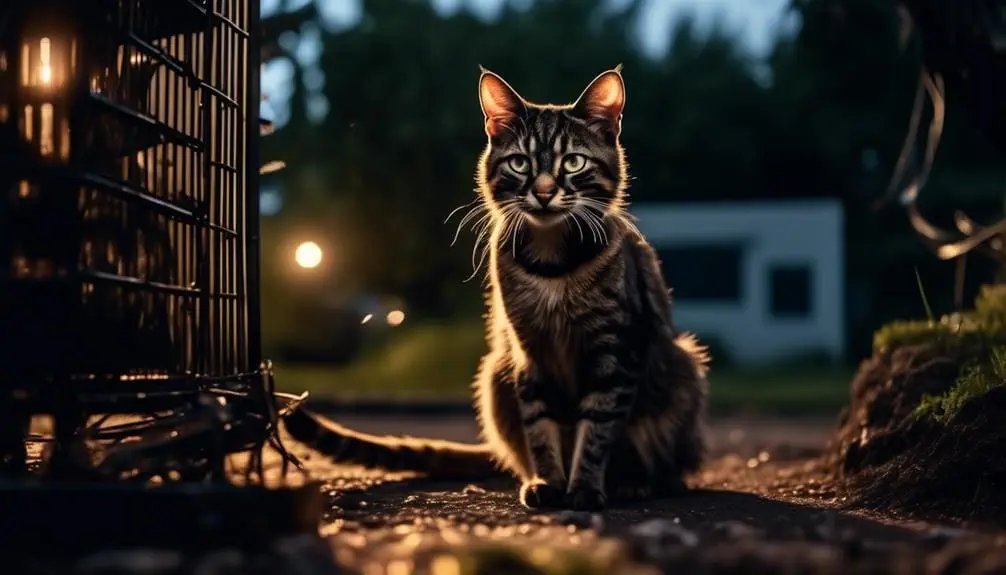The Best Fluffy Pancakes recipe you will fall in love with. Full of tips and tricks to help you make the best pancakes.

Feral cats pose a unique challenge when it comes to trapping and handling. As a writer who aims to provide professional and insightful information, it is essential to explore the expert techniques used to successfully capture these elusive creatures.
By understanding their behavior and implementing humane methods, we can ensure the safety and well-being of feral cats while controlling their population.
In this discussion, we will uncover the secrets behind creating a safe and calm environment, using enticing techniques, and handling feral cats with care.
Whether you are a concerned citizen or a professional in the field, this article will equip you with the knowledge needed to approach feral cat trapping with confidence and compassion.
Key Takeaways
- Approach feral cats with caution and knowledge of their behavior and potential reactions.
- Create a safe and calm environment to help feral cats feel comfortable.
- Use food, treats, toys, and positive reinforcement to lure and distract feral cats into carriers.
- Seek professional help if unable to safely trap feral cats on your own and consider spaying/neutering to control the population.
Understanding Feral Cat Behavior
Understanding feral cat behavior is crucial for effectively trapping and handling these cats in a safe and humane manner. Feral cats are not socialized to humans and live in colonies, often avoiding contact and being territorial.
To successfully manage feral cat colonies, it is important to use feral cat socialization techniques and implement feral cat colony management strategies. These techniques involve creating a safe and calm environment for the cats, using food and treats to lure them into carriers, and providing them with toys for distraction and comfort.
When handling feral cats, it is essential to approach them with caution, use gloves and towels if necessary, and avoid sudden movements or loud noises.
Creating a Safe and Calm Environment
To create a safe and calm environment for feral cats, it is essential to implement strategies that alleviate their anxiety and fear. Reducing feral cat anxiety requires effective strategies that promote trust and comfort.
One such strategy is to use pheromone sprays or diffusers, which release calming scents that help reduce anxiety and stress. Additionally, playing soft, soothing music or using a white noise machine can create a peaceful atmosphere.
Positive reinforcement is also important in promoting trust and comfort. Rewarding good behavior and ignoring bad behavior helps build a positive association with humans.
Using Food and Treats to Lure the Cat Into the Carrier
Using food and treats strategically is an effective method to entice feral cats into the carrier for safe trapping. When dealing with feral cats, it is important to remember that they are not accustomed to human interaction and may be fearful or wary. Therefore, alternative methods of luring them into carriers are necessary.
Positive reinforcement plays a crucial role in trapping feral cats, as it helps to build trust and create a positive association with the carrier. Placing the carrier in their environment with the door open and using treats just inside the entrance can help entice the cat to investigate and eventually enter the carrier.
Additionally, using a fishing pole toy or laser pointer can guide the cat towards the carrier. Patience is key, allowing the cat to approach the carrier at their own pace.
Using Toys
Positive reinforcement through the use of toys can be a valuable tool when it comes to trapping feral cats safely and effectively. By incorporating interactive toys into the trapping process, you can create a play area that will engage the cats and make them feel more comfortable and secure.
Here are three ways to use toys when trapping feral cats:
- Introduce interactive toys inside the carrier to distract the cats and keep their attention away from the trap. Toys like laser pointers or fishing pole toys can be used to engage the cats and redirect their focus.
- Create a play area for feral cats near the trap. Use toys that encourage curiosity and playfulness, such as puzzle toys or feather wands. This will help to reduce their stress and anxiety and make them more likely to approach the trap.
- Use toys to reward good behavior during the trapping process. For example, you can use a treat-dispensing toy to reinforce positive actions, such as approaching the carrier or entering the trap. This positive reinforcement will help to build trust and make the trapping experience more positive for the cats.
Handling Feral Cats With Care
When handling feral cats, it is crucial to approach them with caution and employ proper techniques to ensure their safety and minimize the risk of injury. Safety precautions should be taken to protect both the handler and the cat. It is important to wear gloves and use a towel to handle the cat if necessary, as feral cats may scratch or bite when feeling threatened. Avoid sudden movements or loud noises that can startle the cat and cause aggression.
When handling the cat, grab them on the back of the neck to avoid being scratched or bitten. Wrapping them in a towel before placing them in a carrier can help keep them calm and secure. It is important to create a quiet and dark environment in the carrier to reduce stress and anxiety.
Conclusion
In conclusion, Trapping Feral Cats: Expert Techniques Revealed offers a wealth of practical knowledge on capturing and handling feral cats in a safe and humane manner. By understanding their behavior and implementing effective techniques, individuals can create a calm environment that minimizes stress and anxiety for these elusive creatures.
The use of food, treats, toys, and alternative trapping methods can greatly aid in the successful capture and transportation of feral cats. Seeking professional help when needed is also encouraged to ensure the well-being of these vulnerable animals.
Ultimately, spaying and neutering remain essential for responsible population control.








